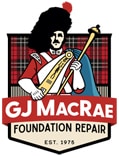Is your house made of brick? Brick is a beautiful, long-lasting building material that stands the test of time and improves with age! It is a common building material in many of the older homes within the Greater Toronto Area. However, like most things in and around your home, it occasionally requires some upkeep. Keep reading to learn more about Pointing and Parging and how important they are to keeping your home safe and happy!
What is Pointing?
Pointing is the process of adding mortar to the gap in between the bricks. The issue today is that many companies do not know how to properly manage the upkeep of brickwork. Too often we are seeing companies use modern materials, such as cement to repair brick. The issue with this is not only cosmetic. Older brick homes were built so that the building could absorb moisture and then let it naturally dry out. This process has a large impact on the condition of the wall as well as its appearance. Incorrect Pointing can lead to water being trapped behind the dense mortar. This can then lead to leaks and physical damage to the stone, brick, and the integrity of your home! When the Pointing repair process is done correctly, it can assist in waterproofing as well as stabilizing the structure of the walls.
What are the Types of Pointing?
There are three different types of Pointing. Each type of Pointing involves a different process and creates a different look. Keep reading to learn more about the three types of Pointing!
1.Tuck Pointing
Tuck Pointing is an English term that involves a highly skilled and refined method of Pointing brickwork. In this method, the pigmented base mortar, also known as the stopping mortar, is put into the joints to match the bricks. Once the mortar has begun to dry, a groove is carved into it and a piece of Lime Putty is carefully placed. Why Lime Putty? Houses, although solid, were built to shift and move with the land they are on. Lime Mortar is flexible, which means that it can move, and self-heal to a certain degree. It also has the amazing ability to take in water, carbon dioxide and grow tiny calcite crystals. Tiny calcite crystals can cover the span of the crack and tie both sides together. Visually, Tuck Pointing also gives the illusion that the brickwork is perfect.
2.Ribbon Pointing
Ribbon Pointing is a popular finish. It is similar to Tuck Pointing, but requires less time and labor. This process involved using a trowel along the mortar joints to create a groove. Although less intense than Tuck Pointing, Ribbon Pointing still requires a set of skilled and experienced individuals to achieve perfect results.
3.Flush Pointing
Flush Pointing, also known as Bagged Pointing, involves pulling the trowel along the mortar at a 90-degree angle to the wall. This process leaves a semi-rough finish along the joint and gives a rustic appearance. Many of our clients love the look of Flush Pointing!
What is Parging?
Parging is the coating that is applied to the above-grade portion of your foundation walls. The mixture used for Parging is made up of mortar and cement mix. This coating is used for decoration, but it also plays a large part in sealing cracks and keeping your home warm and dry. Even though the parging is typically only visible above grade, it often goes all the way down to the wall to the footing.
Why Do Parging Cracks Appear?
Now that you know what Parging is, you may have noticed some cracks in your Parging. Parging is used as a moisture barrier, but it can sometimes become wet itself. When this happens, the water inside the parging can freeze and expand, which results in cracks. The above-ground and below-ground Parging will be affected differently by the weather and the seasons. If you notice a crack, it is best to contact the experts at GJ MacRae. Our team will be able to determine whether or not the crack is in your Parging or your Foundation, and we can work with you to determine the best steps to take.
Should You Waterproof A Parged Wall?
Although you may like the look of a painted and waterproofed wall, the risk to your home is not worth the style. Parged walls were built and designed to be able to breathe. By putting a layer of waterproofing material or paint on the wall, you are stopping it from doing what it was built to do. The paint no matter what kind will just peel off anyway, because of the moisture the wall attracts. This means more work for you and less money in your pocket! If you want to keep your home safe and dry, only waterproof below grade!
Should I Try DIY Pointing/Parging?
Although Pointing and Parging may seem like straightforward and simple procedures, there is a lot that goes into each process. Without the experience and the expertise, you could use the wrong style or material, which could result in serious damage to your home. The safest and best step to ensure your home is safe, and secure is to contact the experts at GJ MacRae. We know our stuff!
Can I Renovate My Brick Home?
Alterations of stone and brickwork homes are very common. If you are thinking about renovating your brick home, it is very important that you hire a team that understands the structure of your home, and how to keep it sturdy and safe. We treat each project as the unique case that it is, and always ensure that your home is strong and secure. Whether you’re looking to add an addition or begin underpinning, call the experts at GJ MacRae to get started!
The GJ MacRae Difference
If you notice an issue with your Brickwork, Pointing, or Parging, contact the experts at GJ MacRae today! Our team will visit your home, assess the situation, and work with you to find the best course of action! We work together as a team to provide all of our customers with the specialist elements of brickwork repairs. We take pride in being able to restore older buildings to their former glory! Call us or visit our website today to get started.






